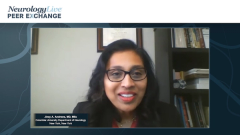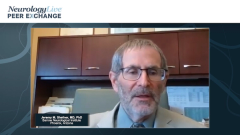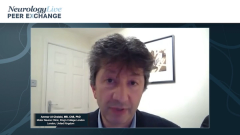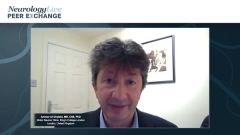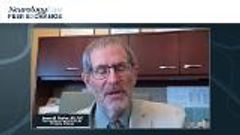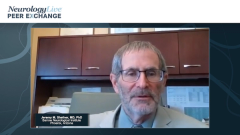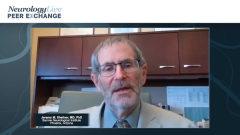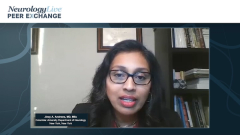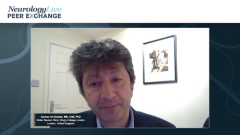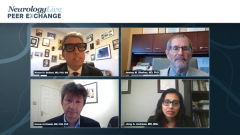
Ongoing Clinical Trials and the Future of ALS
Key opinion leaders review the study design and mechanisms of action for drugs in ongoing clinical trials and consider the future of amyotrophic lateral sclerosis (ALS).
Episodes in this series

Richard S. Bedlack, MD, PhD, MS: Jeremy, I have heard about a drug called arimoclomol. What can you tell us about that?
Jeremy M. Shefner, MD, PhD: Arimoclomol has probably been around the ALS [amyotrophic lateral sclerosis] community for 15 years. It is a drug that was evaluated in preclinical models first and is a coinducer of a heat shock protein called Hsp70. Heat shock proteins are chaperones that help remove toxic elements from a cell. More research has been done on arimoclomol preclinically, and it clearly has a direct effect on lysosomal activity, and it enhances the ability of lysosomes and cells to clear protein aggregates. It was studied in a study of 100 patients. It was a 3-month study, and it was shown to be well tolerated and have good CNS [central nervous system] penetrance.
It was then studied in a group of patients with familial ALS with SOD1 mutations. Although that was a small study, there was a suggestion that it was positive in that group. It has then been studied in a variety of storage diseases including a disease called Niemann-Pick. A phase 3 study of Niemann-Pick was reported as positive, and the drug is being considered by the FDA for approval in that regard. In the context of a relatively large, relatively long placebo-controlled trial, arimoclomol is close to completion in ALS. I do not know the dates, but it is likely to be sometime this quarter or next when we will get the results, and we will find out whether it has a role.
Richard S. Bedlack, MD, PhD, MS: Thank you. Ammar, the next on our list of tongue twisting medications is masitinib.
Ammar Al-Chalabi, MB, ChB, PhD: Masitinib was part of a remarkably complex study design. It was a phase 2b/3 study. It transitioned seamlessly from phase 2 to 3. Masitinib itself is a tyrosine kinase inhibitor. It modulates mast cells and macrophages, and it and is thought to have neuroinhibitory, neuroprotective properties. The study randomized 394 people 1:1:1 of placebo with riluzole, masitinib at 3 mg/kg per day with riluzole, or masitinib 4.5 mg/kg per day with riluzole. In other words, everyone was given riluzole, and people were either given placebo or low-dose or high-dose masitinib.
That was the basic dosing regimen, but that was superimposed on top of another stratification of patients. Patients were assessed for their ALS FRS [Functional Rating System] rate of decline and classified as normal progressors, which was defined as a rate of decline of 1.1 points or less per month, or fast progressors. They then ended up with people who were normal progressors on either of the 2 dose types or placebo. They then grouped normal progressors and fast progressors as the other group. It was not normal or fast; it was normal and fast as the comparator arm on the 3 different arms. It was an incredibly complex study design, which is part of the reason it has been difficult for the community to understand the results.
The main result was that, for the people who were normal progressors and had a high dose, there was a significant difference in the rate of disease progression. There was an improvement in the rate of disease progression compared with the other arms, but the difficulty was that, even though these were prespecified by the study team as analyses, it was regarded as multiple testing and just trying every single thing in the hope that 1 would come out positive, which is not necessarily a fair interpretation of it.
That is part of the difficulty is that this is a complex study design. The idea would be to go back and do the phase 3 study with a simpler study design and try with the normal progressors at a high dose and see what that shows.
Richard S. Bedlack, MD, PhD, MS: Jeremy, this past summer, in the New England Journal of Medicine, we saw the results of our first gene therapy trial in ALS. It was of a drug called tofersen. Can you tell us about that?
Jeremy M. Shefner, MD, PhD: Tofersen is an antisense oligonucleotide, meaning it is a string of nucleic acids that was actually engineered to match a string of nucleotides that exist in the SOD1 gene. The purpose of this is that the antisense binds to the gene, inhibits production, and potentially even then provides a substrate for which the gene and the antisense together can be degraded. It was shown to reduce the amount of SOD1 protein successfully, whether mutant or normal, in experimental animals and in human subjects with ALS.
What was reported in the New England Journal of Medicine study was a seamless phase 1/2, phase 2 study where patients were initially given low doses of tofersen and then somewhat higher doses. The number of subjects at the higher dose was somewhat enriched so that they had a small number of patients there, but they potentially had enough to look at efficacy variables. They were now looking at patients with SOD1 who were rapidly progressive. Even over 3 months, you expect these patients to decline quite dramatically.
The patients who were on the higher dose of tofersen, who were rapidly progressive, essentially progressed not at all for those 3 months. Even though it was a short study and even though it was a small number of people, that difference is apparently dramatic and suggests that this could be a dramatically effective treatment for patients with this form of ALS. An ongoing study is testing that same higher dose in a larger number of people to make sure that this is not a fortuitous finding.
One of the findings that also suggested this is potentially real is that a biomarker of axon degeneration on neurofilament light chain also was clearly reduced in patients taking tofersen. Neurofilament light chain is reliably increased in patients with ALS. Overall, this is quite encouraging.
Richard S. Bedlack, MD, PhD, MS: That sounds very exciting. Jinsy, how about ibudilast?
Jinsy A. Andrews, MD, MSc: I will talk quickly about ibudilast, which is also referred to as MN-166, which is an investigational product. It is still in clinical trials. Ibudilast is an anti-inflammatory drug. It is a phosphodiesterase inhibitor, but it also inhibits the macrophage migration inhibitory factor. It is meant to be neuroprotective by helping to protect the motor neurons and prevent degeneration. It has already completed early phase clinical trials. It demonstrated a decent safety and tolerability, but the question now is its effectiveness. In the United States, and I believe there are sites in Canada as well, the clinical trial has launched and is actively recruiting for participants in a 12-month study. The randomization is 1:1 placebo or treatment. After that 12-month duration, the open-label extension will continue to be offered to the participants who complete that 12 months placebo-controlled study. The study is recruiting, and we are awaiting results.
Richard S. Bedlack, MD, PhD, MS: This was a very exciting section. If I could look into a crystal ball and think about what the future in ALS might look like, there may come a day when we can pick off individual patients based on the specific cause of their disease. We could say there is 1 specific gene that we can go after and maybe stop the progression in that small percentage of patients. For everybody else, we may have a cocktail of medications that hit different downstream mechanisms, which is so-called rational polypharmacy. It is exciting to think about that.
Let me ask 1 last question. I am going to ask this to each of you: If you could give 1 piece of advice to a community neurologist who is seeing a patient with ALS, what would it be? Jinsy?
Jinsy A. Andrews, MD, MSc: I would ask for our community neurologists to know that ALS should not be said in the same sentence as “death sentence.” There is something that we can do for these patients, so they must try to identify these patients earlier and get them to an ALS center as quickly as possible.
Richard S. Bedlack, MD, PhD, MS: Ammar?
Ammar Al-Chalabi, MB, ChB, PhD: Mine would be to think of ALS because, for the reasons everyone has discussed already, it can be difficult to think of. As Jinsy says, do not destroy hope. It is important to refer early and not destroy hope.
Richard S. Bedlack, MD, PhD, MS: Lastly, Jeremy?
Jeremy M. Shefner, MD, PhD: I will sound like a broken record, but I completely agree that it is important not to destroy the person’s view of a life that is worth something and that ALS is best cared for in a multidisciplinary clinic. If there is 1 available in your area, please think about referral.
Richard S. Bedlack, MD, PhD, MS: I appreciate spending this time with the 3 of you. I do not know if I have ever gotten this much of your time before, but I have learned a lot from all of you today. To our audience, thank you for watching this NeurologyLive® Peer Exchange. If you enjoyed the content, please subscribe to our e-newsletters to receive upcoming Peer Exchanges and other great content right in your in-box.
Transcript Edited for Clarity
Newsletter
Keep your finger on the pulse of neurology—subscribe to NeurologyLive for expert interviews, new data, and breakthrough treatment updates.

